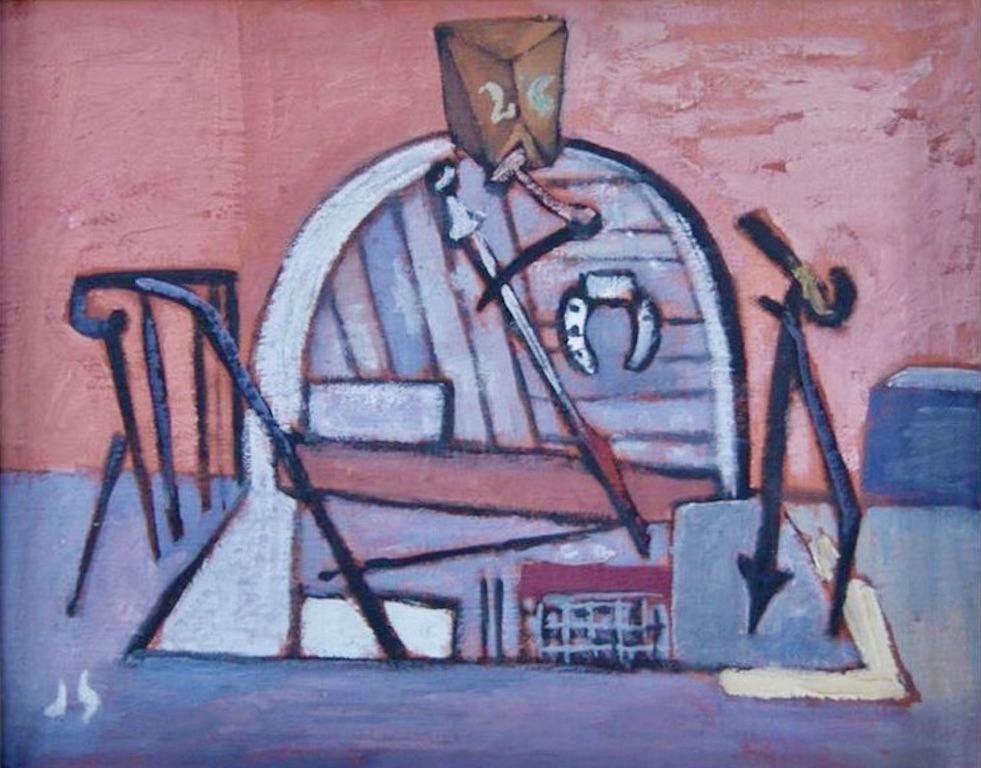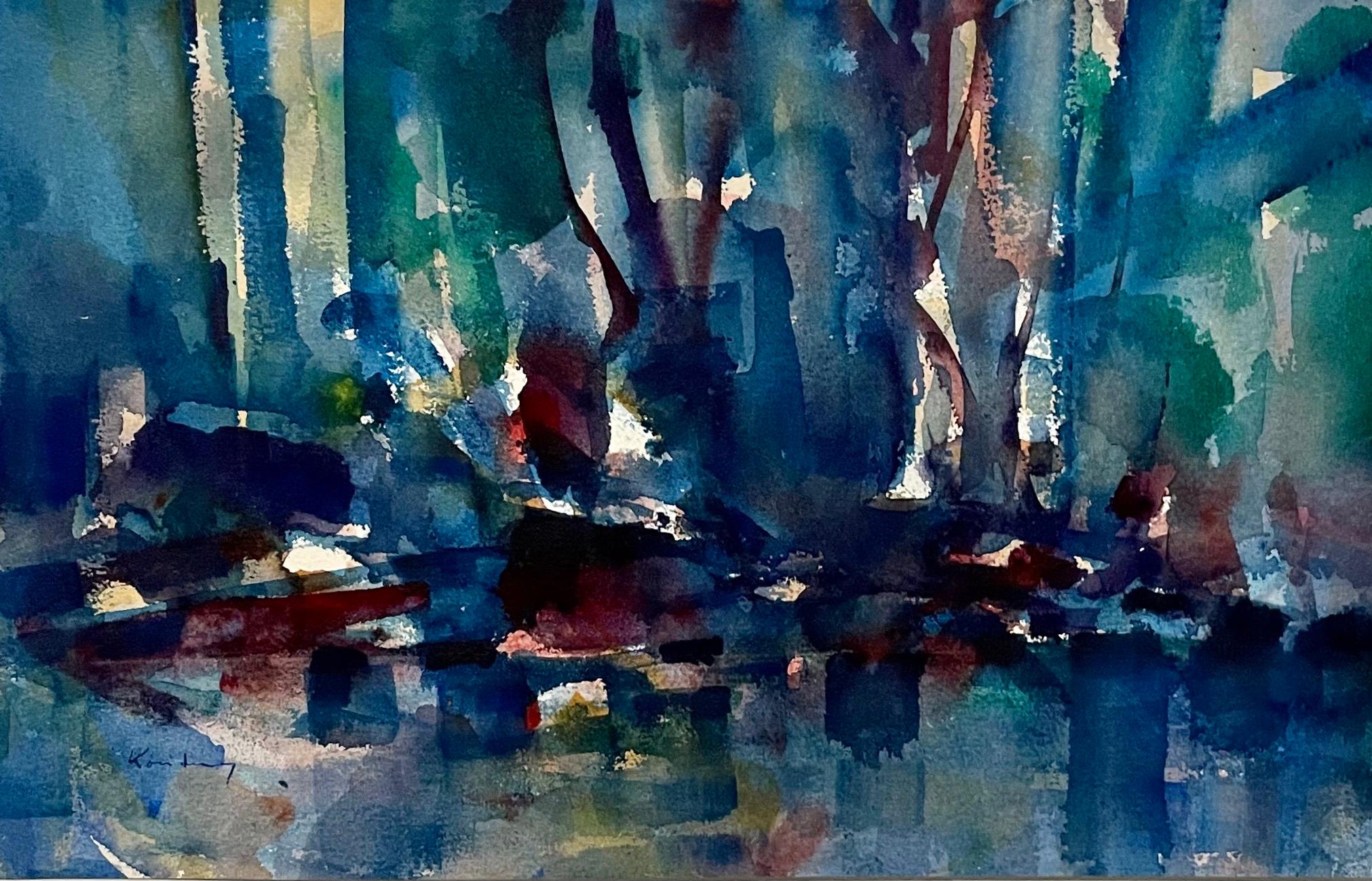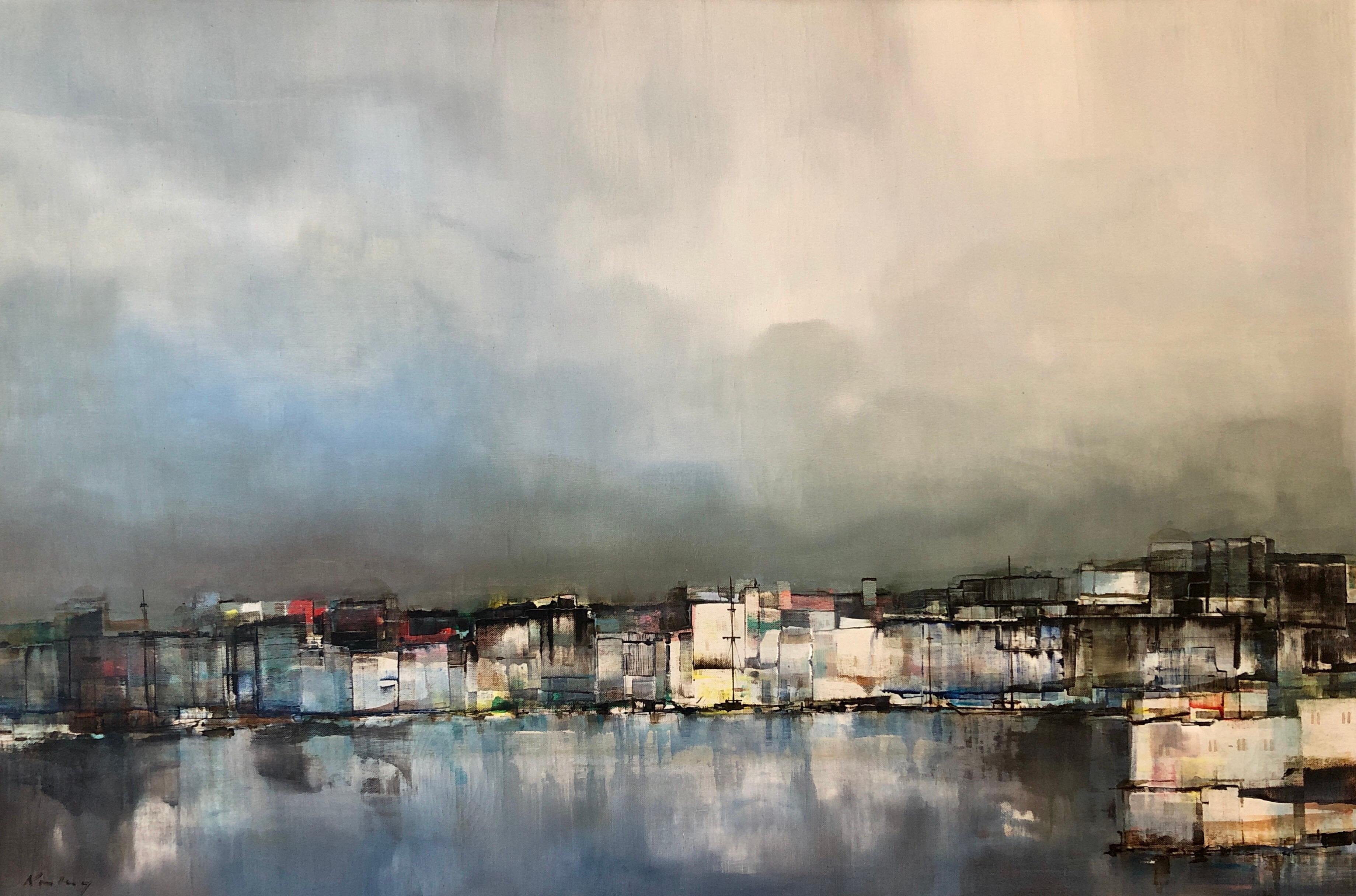Items Similar to Amish Farmscape #3
Want more images or videos?
Request additional images or videos from the seller
1 of 5
Edmund LewandowskiAmish Farmscape #3
About the Item
Amish Farmscape #3, 1984, oil on canvas, 40 x 30 inches, signed and dated lower right; signed, dated, and titled verso
About the Painting
Amish Farmscape #3 is part of a multi-painting series of barns completed in the early 1980s for an exhibition at New York’s prestigious Sid Deutsch Gallery. Lewandowski painted this work at an important point in his career. It was the first major project undertaken by Lewandowski after his retirement from serving as the Chairman of Winthrop University’s Art Department, the last academic position he held after teaching for nearly thirty years. Lewandowski had been inspired to work on the series by a visit to Lancaster County, Pennsylvania. Like his friend and mentor, Charles Sheeler, Lewandowski had always been fascinated by vernacular architecture and the Amish barns of Pennsylvania brought back memories of rural scenes Lewandowski had painted in the Midwest much earlier in his career. Amish Farmscape #3 is a strong example of Lewandowski’s late precisionist work. The complexity of the composition and Lewandowski’s technical acumen are on full display. Being relieved of the burdens of teaching and administering a university art department likely allowed Lewandowski greater freedom and most importantly more time to complete the Amish Farmscape series. Although Lewandowski’s brand of precisionism changed throughout the years, he never deviated from the core tenets of the Immaculate School artists. In this work, we see simplified and flattened forms, the use of ray-lines to define light and space, the elimination of extraneous details, a polished almost machine-like finish, and the complete lack of visible brushstrokes, all hallmarks of the precisionist painters. Lewandowski was the last of the 20th century precisionists and in Amish Farmscape #3, we see just how successfully he continued to work in this style until his death in 1998.
About the Artist
Edmund Lewandowski was among the best of the second-generation precisionist painters. He was born and raised in Milwaukee, Wisconsin and studied at the Layton School of Art with Garrett Sinclair. Lewandowski achieved early success when in 1936 two of his watercolors were shown at the Phillips Collection as part of a Federal Art Project exhibition. Then, in 1937, his work was first exhibited at Edith Halpert’s Downtown Gallery which represented Lewandowski into the 1950s. Under Halpert’s guidance, Lewandowski continued to explore watercolor as his main medium during the 1930s and 1940s, since the gallery already represented Charles Sheeler, who worked primarily in oils. Sheeler became Lewandowski’s major influence as the primary leader of the ill-defined, but very recognizable Immaculate School artists, which included other Downtown Gallery painters, Niles Spencer, George Ault, and Ralston Crawford, as well as Charles Demuth and Preston Dickinson, both of whom died at a young age and had been represented by the Charles Daniel Gallery. Sheeler is credited with giving Lewandowski technical advice on how to make his paintings more precise and tightly rendered and by all accounts, Sheeler was a fan of Lewandowski’s work. Through the Downtown Gallery, Lewandowski’s paintings were accepted into major national and international exhibitions and purchased by significant museums and collectors. Franklin and Eleanor Roosevelt and Nelson Rockefeller acquired works by Lewandowski. He was included in the Museum of Modern Art’s important 1943 exhibition, American Realists and Magic Realists as well as juried exhibitions at the Whitney Museum of American Art, the Pennsylvania Academy of Fine Arts, and the Art Institute of Chicago. Lewandowski also completed commissions for magazines during the 1940s and 1950s, including several covers for Fortune. Throughout his career, Lewandowski explored urban and rural architecture, industry, machinery, and nautical themes. Looking back on his career, Lewandowski wrote, “My overwhelming desire as an artist through the years has been to record the beauty of man-made objects and energy of American industry on canvas. For as far back as I can recall, the cityscapes, farms and depictions of industrial power and technological efficiency has had a great attraction for me. I try to treat these observations with personal honesty and distill these impressions to a visual order.” Lewandowski is credited with extending precisionism to the Midwest and successfully continuing the style into the 1990s, three decades after Sheeler’s death and six decades after Demuth’s passing. Late in his career, Lewandowski enjoyed a resurgence of popularity as he was represented during the 1980s by New York’s Sid Deutsch and Allison Galleries before joining Keogh & Riehlman during the 1990s. Lewandowski’s work was the subject of a retrospective and accompanying catalog in 2010. He is listed in Who was Who in American Art and all other standard references.
- Creator:Edmund Lewandowski (1914 - 1998, American)
- Dimensions:Height: 30 in (76.2 cm)Width: 40 in (101.6 cm)Depth: 2 in (5.08 cm)
- Medium:
- Movement & Style:
- Period:
- Condition:
- Gallery Location:Los Angeles, CA
- Reference Number:1stDibs: LU1859211389022
About the Seller
No Reviews Yet
Vetted Seller
These experienced sellers undergo a comprehensive evaluation by our team of in-house experts.
1stDibs seller since 2022
6 sales on 1stDibs
Typical response time: 8 hours
- ShippingRetrieving quote...Ships From: Los Angeles, CA
- Return PolicyA return for this item may be initiated within 3 days of delivery.
More From This SellerView All
- Abstract Street (Untitled)By Hananiah HarariLocated in Los Angeles, CAThis painting is part of our exhibition America Coast to Coast: Artists of the 1930s Abstract Street (Untitled), 1939, oil on canvas, signed and dated lower right, 12 x 32 inches; provenance includes a private collection in Venice, California; presented in what is likely the artist's original handmade frame About the Painting The present work is the culmination of a series of mainly horizontal urban abstractions Harari completed between 1937 and 1939. Deeply influenced by Stuart Davis, Harari’s New York streetscapes began with clearly recognizable objects and landmarks as in Into New York (1937 - Collection of the Whitney Museum of American Art), New York Harbor (1937), Up and Downtown (1938), and his other mural proposals for the Nurses Home on Welfare Island (1937) and the Williamsburg Housing Project (1938). At the end of the series, Harari’s vistas became increasingly abstract with broad planes of color representing buildings and streets, the slightest cross-hatching forming a bridge or elevated train track and the vague suggestion of a streetlight looping in the right center of the composition. Figures, birds, and a street vendor’s cart are reduced to pictograms scratched into the surface of the canvas. Abstract Street (Untitled) is among Harari’s most spare works of the 1930s and 1940s and calls to mind the seemingly childlike, but deeply sophisticated works of Paul Klee from the 1920s. It serves as an excellent reminder of why Harari was heralded as one of the earliest members of the American Abstract Artists. About the Artist Hananiah Harari was an artistic polyglot who was equally at home working in styles as diverse as Cubism, Constructivism, Expressionism, Hard Edged Abstraction and trompe l’oeil Realism. A native of Rochester, New York, Harari initially studied as a child at the Memorial Art Gallery in his hometown and later as a scholarship student at the College of Fine Arts at Syracuse University. In 1932, Harari left for Paris where he befriended Nahum Tschacbasov, Benjamin Benno and John Graham and studied at the ateliers of Lhote, Leger and Gromaire. He also studied fresco painting at the Ecole de Fresque. By 1933, Harari had completed enough work and gained a sufficient reputation to have a solo exhibition at the American Club in Paris. The following year, Harari and his childhood friend and fellow artist Herzl Emanuel traveled to Palestine, where the artists worked hard in the orchards and fields of Kibbutz Deganiah, but produced little art. After returning to New York, Harari married Emanuel’s sister, Freda, and set out on the development of what noted scholar Gail Stavitsky has called an “original synthesis of the old and new." Harari became an early member of the American Abstract Artists (AAA), an organization formed to give modernists exhibition opportunities. Harari was also a member of the socially conscious Artist’s Union and the American Artist’s Congress. From 1936 through 1942, Harari worked on the Federal Art Project and assisted Marion Greenwood on a project as part of the Mural Division, but to his disappointment did not lead his own project. During the late 1930s and early 1940s, Harari completed a series of paired paintings with the same subject matter depicted in a Cubist manner and in trompe l’oeil Realism. Harari was acclaimed by Clement Greenberg and six of the artist’s works were selected for the Museum of Modern Art’s important 1943 exhibition American Realists and Magic Realists. During World War II, Harari served in the US Army Air Corps. Following the war, Harari continued to produce fine art while also producing commercial art. During the McCarthy Era, Harari’s progressive politics and leftist leaning art...Category
1930s American Modern Abstract Paintings
MaterialsOil
- LandscapeBy Marcel Emile CaillietLocated in Los Angeles, CALandscape, 1940, oil on canvas, 24 x 20 inches, signed, dated and titled verso: “Marcel Cailliet ’40 – S.C.” and “Marcel Cailliet Landscape”; likely exhibited at the annual juried st...Category
1940s American Modern Paintings
MaterialsCanvas, Oil
- Untitled (Collapsed Shacks)By Karl FortressLocated in Los Angeles, CAUntitled (Collapsed Shacks), c. 1940s, oil on canvas, signed lower left, 20 ½ x 26 ½ inches, presented in a period frame This work is part of our exhibition America Coast to Coast: ...Category
1940s American Modern Paintings
MaterialsCanvas, Oil
- Untitled (Farm in Winter)By Julius M. DelbosLocated in Los Angeles, CAThis work is part of our exhibition America Coast to Coast: Artists of the 1940s Untitled (Farm in Winter), 1940s, oil on canvas, signed lower right, 26 x 30 inches, presented in a...Category
1940s American Modern Paintings
MaterialsCanvas, Oil
- Arthur KillLocated in Los Angeles, CAThis painting is part of our exhibition Charles Goeller: A Wistful Loneliness. Oil on canvas, 15 ¾ x 24 inches, Signed and titled verso on stretcher Exhibited: [Solo Exhibition] Cha...Category
1940s American Modern Landscape Paintings
MaterialsOil, Canvas
- Across the StreetLocated in Los Angeles, CAThis painting is part of our exhibition Charles Goeller: A Wistful Loneliness. Oil on canvas, 16 x 12 inches, Signed lower right Exhibited: 1) [Solo E...Category
1940s American Modern Landscape Paintings
MaterialsOil, Canvas
You May Also Like
- WPA American Scene Modernism 20th Century NYC Industrial "Cellar with Horseshoe"By Joseph SolmanLocated in New York, NY"Cellar with Horseshoe" WPA American Scene Modernism 20th Century NYC Industrial Joseph Solman (1909-2008) "Cellar with Horseshoe," 16 x 20 inches, oil on canvas circa 1938, initial...Category
1930s American Modern Landscape Paintings
MaterialsCanvas, Oil
- Orbs, Spiritual and Abstract LandscapeLocated in Doylestown, PA"Orbs" is a 38 x 50 inches, oil on canvas painting by American modernist and surrealist, female artist Peter Miller. The work is estate stamped 202141 on verso. The painting has been...Category
1950s American Modern Abstract Paintings
MaterialsCanvas, Oil
- Salutations, Architectural Abstract Scene, Cultural and Spiritual CommentaryLocated in Doylestown, PA"Salutations" is a 12 x 16 inches, oil on canvas painting by American modernist and surrealist, female artist Peter Miller. The work is painted in a vibrant color palette. The painti...Category
1940s American Modern Abstract Paintings
MaterialsCanvas, Oil
- Forest, American Modernist Abstract Landscape Painting by Female ArtistLocated in Doylestown, PA"Forest" is a 29 x 36 inches, oil on canvas painting by American modernist, female artist Peter Miller. The work is painted in a vibrant color palette. The work is estate stamped on ...Category
1940s American Modern Abstract Paintings
MaterialsCanvas, Oil
- Modernist Abstract Expressionist Watercolor Painting Bauhaus Weimar Pawel KontnyBy Pawel KontnyLocated in Surfside, FLAbstract watercolor composition bearing the influence of the earlier color-block compositions of Paul Klee. Pawel August Kontny, (Polish-German-American artist) He was born in Laurahuette, Poland, in 1923, the son of a wealthy pastry shop owner. In 1939 he began studying architecture in Breslau where he was introduced to the European masters and to the work of some of the German Expressionists, soon afterward banned as "degenerate artists" and removed from museums throughout Germany by the Nazi regime. His studies were interrupted by World War II. Drafted into the German army, traveling in many countries as a soldier, he sketched various landscapes but in 1945, he was captured and held as a prisoner of war in Italy. After the war, he studied at the Union of Nuremberg Architects to help design buildings to replace ones destroyed in the war. He recorded his impressions of the local population and the landscapes through his watercolors and drawings. Pawel Kontny thereafter moved to Nuremberg, Germany, becoming a member of the Union of Nuremberg Architects and helping to rebuild the city's historic center. He soon decided to concentrate on his professional art career. He married Irmgard Laurer, a dancer with the Nuremberg Opera. Pavel Kontny 's career as an artist was launched with his participation in an all German exhibition, held at the Dusseldorf Museum in 1952. He held one-man shows in Germany, Switzerland and the United States. During his trip to the United States in 1960, Kontny became instantly enamored with Colorado, and decided to relocate to Cherry Hills with his wife and two children. He quickly established himself in the local art community, being affiliated for a time with Denver Art Galleries and Saks Galleries. His subject matter became the Southwest. During this time he received the Prestigious Gold Medal of the Art Academy of Rome. His extensive travel provided material for the paintings he did using his hallmark marble dust technique. he also worked equally in pastel, watercolor, charcoal and pencil-and-ink. in a style which merged abstraction and realist styles, influenced by Abstract Expressionist painting and South Western American landscapes. In the early 1960s he was one of only a few European-born professional artists in the state, a select group that included Herbert Bayer (1900-1985), a member of the prewar Bauhaus in Weimar and Dessau, Germany, and Roland Detre (1903-2001), a Hungarian modernist painter. As a Denver, Colorado resident, Pavel Kontny exhibited at galleries and museums throughout the United States, Germany and Japan. There, he was inspired by frequent trips to Native American pueblos in the Southwest, as well as by the study of the Plains Indians of Montana and Wyoming. Over the years Kontny had a number of students and generously helped young artist by hosting exhibitions at his Cherry Hills home. For many years he generously donated his paintings to support charitable causes in Denver. Influences during his European years included German pastelist C.O. Muller, German Informel painter Karl Dahmen and Swiss artist, Hans Erni. In the early 1950s his painting style showed the influence of the Die Brücke (The Bridge), a group of German expressionist artists formed in Dresden in 1905 who had a major impact on the evolution of modern art in the twentieth century in Germany. By the middle of the decade his style incorporated more referential abstraction and total abstraction, resulting in part from his study of Hans Hartung, a German artist based in Paris who exhibited his gestural abstract work in Germany. The American moon landing in 1969 inspired Paul Kontny...Category
20th Century American Modern Landscape Paintings
MaterialsCanvas, Oil
- Modernist Colorado Oil Painting Abstract Cityscape Harbor Scene Pawel KontnyBy Pawel KontnyLocated in Surfside, FLUrban landscape of city harbor, marine scene, (North Africa?) bearing the influence of the earlier color-block compositions of Paul Klee. Modernist Cityscape 24" x 36" sight. oil on ...Category
20th Century American Modern Landscape Paintings
MaterialsCanvas, Oil
Recently Viewed
View AllMore Ways To Browse
Modern Rural Landscape
My Account
Mid Century Urban Landscapes
Modern Amish
Midcentury Urban Landscape
Mans Best Friend
Mid Century Fan Art
1930s Industrial Painting
Charles Leader
Barn Series
Charles Urban
Vintage Canvas Brand
Landscape Painting Nautical
My Last Purchase
Ray Urban
Sinclair A
Lancaster County
Nile Painting


